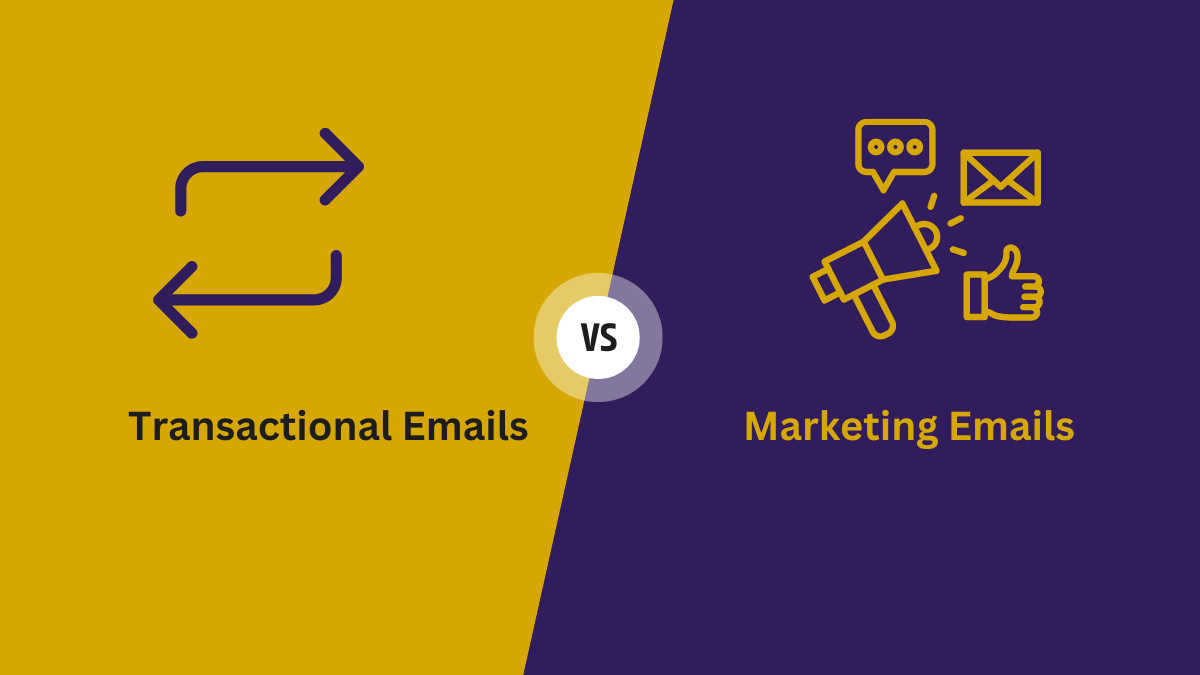
The difference between transactional emails and marketing emails may seem obvious at first glance – one is designed to let customers know their order is ready for pickup, while the other concerns promotional offers or discounts. However, as marketers, you need to understand the nuances of both types of emails and when it’s appropriate to send them to optimize your results and satisfy customer engagement preferences. In this blog post, we’ll cover the key differences between transactional vs marketing emails so you can craft strategies that make an impact on your bottom line.
What Is a Transactional Email?
A transactional email contains information about an action the recipient has already taken, while a marketing email intends to drive the recipient toward an action you want them to take. By putting the customer at the center of every interaction, transactional emails can create a consistent level of engagement with your audience while also driving additional sales opportunities. While they may sound intimidating, creating tailored content and keeping track of data points is very simple once you understand how these types of messages work. In this blog post, we’ll explore what exactly transactional emails are and discuss how you can use them to build relationships with customers and increase sales in your business.
Read Also:
What Is a Marketing Email?
Do you need help learning the basics of marketing emails? You’re in luck because understanding what a marketing email is and how it works is an integral part of any successful digital marketing strategy. Marketing emails are designed to engage current customers while helping you attract new ones, so they’re incredibly valuable to any business. In this blog post, we’ll take a look at what exactly makes up a good marketing email, as well as some tips for writing them effectively. With these insights, you can create targeted messages that drive engagement and increase sales with minimal effort. Keep reading to find out more!
What Are The Key Differences Between Transactional Emails vs Marketing Emails?
Purpose
The first and most obvious difference between transactional emails and marketing emails is their purpose. Transactional emails are sent in response to an action that a customer has taken, such as making a purchase or signing up for a service. They typically contain information that is relevant to the transaction, such as a confirmation of the purchase or a shipping update. Marketing emails, on the other hand, are sent in order to promote a product or service. They typically contain general information about the product or service, as well as special offers or discounts.
Frequency
Another key difference between transactional emails and marketing emails is their frequency. Transactional emails are usually only sent when there is an update on the transaction, such as a confirmation or shipping update. Marketing emails, on the other hand, are typically sent regularly, such as once a week or once a month.
Content
The content of transactional emails and marketing emails also differs significantly. Transactional emails usually only contain relevant information about the transaction, such as a confirmation of the purchase or a shipping update. Marketing emails, on the other hand, often contain general information about the product or service, as well as special offers or discounts.
Design
The design of transactional emails and marketing emails also differs significantly. Transactional emails are usually designed to be simple and straightforward, with just the relevant information about the transaction. Marketing emails are often designed to be more visually appealing, with images and graphics to catch the reader’s attention.
Call to Action
Transactional emails usually do not contain a call to action (CTA), as they have already served their purpose by providing relevant information about the transaction. Marketing emails often contain CTAs, such as “Buy Now” or “Sign Up Today”, in order to encourage readers to take action.
Target audience
Transactional emails are usually only sent to customers who have already taken action, such as making a purchase or signing up for a service. Marketing emails are often sent to larger groups of people in order to promote a product or service
Examples of Transactional Email

Confirmation Email
A confirmation email is sent to a customer after they have made a purchase. This type of email typically includes information about the order, such as the items that were purchased, the total cost, and the estimated delivery date. A confirmation email may also include a link to the order tracking page so that the customer can track the status of their order.
Shipping Email
A shipping email is sent to a customer after their order has shipped. This type of email typically includes information about the shipping method that was used, the tracking number, and the expected delivery date. A shipping email may also include a link to the order tracking page so that the customer can track the status of their order.
Order Cancellation Email
An order cancellation email is sent to a customer when an order is canceled for some reason. This type of email typically includes information about why the order was canceled and how to contact customer service if there are any questions.
Return/Exchange Email
A return/exchange email is sent to a customer when they need to return or exchange an item that they have purchased. This type of email typically includes instructions on how to return or exchange the item, as well as information on where to send it.
Customer Service Email
A customer service email is sent to a customer when they need to contact customer service for some reason. This type of email typically includes instructions on how to contact customer service, as well as information on what types of issues can be addressed by customer service.
Account Update Email
An account update email is sent to a customer when there is an update to their account information. This type of email typically includes information about what has changed, as well as instructions on how to update any settings or preferences that may be affected by the change.
Password Reset Email
A password reset email is sent to a customer when they need to reset their password for some reason. This type of email typically includes instructions on how to reset the password, as well as a link that can be used to reset the password online.
Example of Marketing Emails

A Welcome Email
A welcome email is a perfect way to introduce yourself to your new subscribers. In your welcome email, you can thank your subscribers for signing up, give them a brief overview of what they can expect from your emails, and let them know how often they can expect to hear from you. You can also include a link to your website or blog so that your subscribers can learn more about you and your business.
A New Product Announcement Email
If you’ve just launched a new product, a great way to market it is with a new product announcement email. In your email, you can include a photo of the product, a brief description of its features and benefits, and a link to where your subscribers can purchase it. You can also offer a discount code or free shipping to encourage your subscribers to buy the product.
A Contest Email
Running a contest is a great way to engage your subscribers and get them excited about your brand. In your contest email, you can explain the rules of the contest, announce the prize, and provide a link for your subscribers to enter. You can also promote the contest on social media and in other marketing channels to reach even more people.
A Sales Email
A sales email is a great way to promote discounts and special offers on your products or services. In your sales email, be sure to include images of the products or services that are on sale, as well as the details of the offer (discount amount, expiration date, etc.). You can also include a call-to-action (CTA) telling your subscribers what you want them to do (e.g., “Click here to shop now!”).
A Customer Appreciation Email
Sending a customer appreciation email is a great way to show your existing customers that you value their business. In your email, you can thank them for their loyalty, offer them exclusive discounts or deals, and let them know about any new products or services that you’re offering. You can also include a CTA encouraging them to spread the word about your business to their friends and family.
An Educational Email
An educational email is a great way to provide value to your subscribers without selling anything. In your email, you can share tips, tricks, or advice related to your industry or niche. You can also include links to helpful resources or blog posts so that your subscribers can learn even more about the topic. And don’t forget to include a CTA telling your subscribers what they should do next (e.g., “Sign up for my course today!”).
A Seasonal Email
Sending a seasonal email is a great way to stay top-of-mind with your subscribers throughout the year. In each seasonal email, you can promote products or services that are relevant to the season (e.g., swimsuits in the summer), share holiday greetings or special deals, or simply remind your subscribers that you’re still around!
Conclusion:
Ultimately, transactional emails and marketing emails each offer unique advantages to business owners. Transactional emails provide a high level of security and privacy, as they are not susceptible to competition or outside interference. On the other hand, marketing emails allow business owners to communicate directly with their customers on a more personal level and keep them informed about upcoming events or products. Whichever type of email you choose for your business needs, it is important to ensure that your message is clear and concise. Understanding the differences between these two types of emails can help you create an effective strategy that will bring in potential customers and give them something compelling to look forward to. Taking the time to craft attractive messages that are tailored specifically towards your target audience can have a great impact on your sales figures—and overall success in running your business.




1 Comment